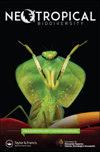Spatial and seasonal variation in polychaete communities according to their trophic categories in Southwest Tobago, West Indies
IF 0.8
Q4 ECOLOGY
引用次数: 2
Abstract
ABSTRACT Bon Accord Lagoon (BAL), Tobago is home to a Thalassia testudinum (K.D. Koenig, 1805) dominated seagrass community and polychaetes usually show an affinity to seagrass beds compared to other environments. The objectives of this study were to investigate the polychaete community associated with the Thalassia beds in BAL, determine seasonal variation, and compare with the neighbouring hard bottom polychaete community in Mt. Irvine Bay (MIB). Benthic macroinvertebrates were sampled using a 15 cm diameter corer at a depth of 10 cm. Six stations were sampled during the wet and dry seasons of 2018. Samples were sieved in the field using a 0. 5 mm mesh screen. They were stained and preserved with a 10% formalin-seawater mixture, sorted and macrofaunal species identified to the lowest possible taxonomic level. Thirty – one polychaete families were ranked according to trophic categories as described by Fauchald and Jumars (1979) and updated where possible. Average family density for the dry season was recorded at 206.89 ± 307.53 ind/m2 and 129.55 ± 227.23 ind/m2 for the wet. Maldanidae and Syllidae recorded highest densities for dry and wet seasons respectively. Deposit feeders were the largest trophic group represented across both seasons in the BAL with Maldanidae being the most dominant. Carnivorous polychaetes dominated MIB with Syllidae being the most dominant. BAL showed higher diversity and richness compared to MIB. Based on functional traits of the community the environment at BAL can be regarded as healthy. This study establishes a much-needed baseline for future research and management of marine biodiversity in southwest Tobago.西印度群岛多巴哥西南部多毛类群落按营养类别的空间和季节变化
摘要:多巴哥Bon Accord泻湖(BAL)是一个以Thalassia testudinum(K.D.Koenig,1805)为主的海草群落的家园,与其他环境相比,多毛类通常对海草床表现出亲和力。本研究的目的是调查BAL中与Thalassia海床相关的多毛类群落,确定季节变化,并与Mt.Irvine Bay(MIB)中邻近的硬底多毛类群落进行比较。使用直径15厘米、深度10厘米的取芯器对底栖大型无脊椎动物进行采样。在2018年的雨季和旱季,对六个站点进行了采样。使用0。5毫米筛网。用10%福尔马林海水混合物对它们进行染色和保存,对它们进行分类,并将大型动物物种鉴定到尽可能低的分类水平。根据Fauchard和Jumars(1979)描述的营养类别,对三十一个多毛类科进行了排名,并在可能的情况下进行了更新。旱季的平均家庭密度为206.89±307.53 ind/m2,雨季为129.55±227.23 ind/m2。Maldanidae和Syllidae分别在旱季和雨季记录了最高的密度。沉积物食性动物是BAL中两个季节中最大的营养群,其中马尔丹科最占优势。肉食性多毛类在MIB中占主导地位,Syllidae占主导地位。与MIB相比,BAL表现出更高的多样性和丰富度。根据群落的功能特征,BAL的环境可以被认为是健康的。这项研究为多巴哥西南部海洋生物多样性的未来研究和管理建立了一个急需的基线。
本文章由计算机程序翻译,如有差异,请以英文原文为准。
求助全文
约1分钟内获得全文
求助全文
来源期刊

Neotropical Biodiversity
Environmental Science-Ecology
CiteScore
1.80
自引率
0.00%
发文量
39
审稿时长
24 weeks
 求助内容:
求助内容: 应助结果提醒方式:
应助结果提醒方式:


